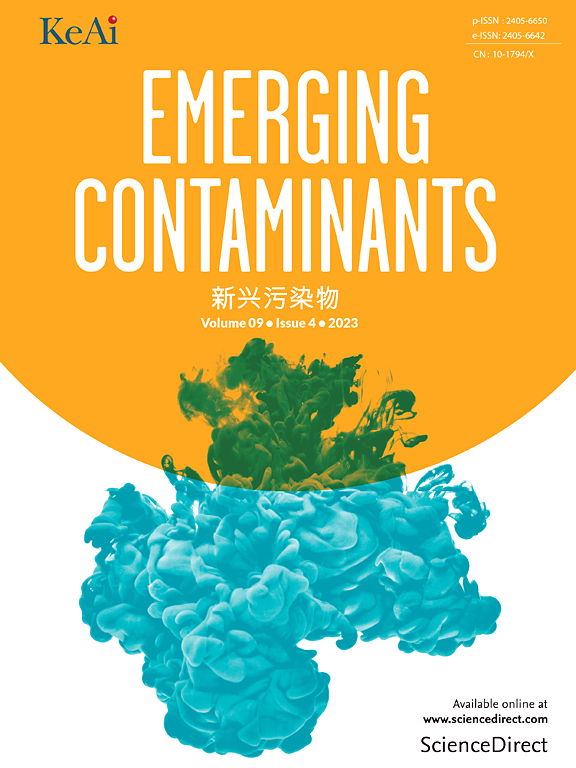饮用水和饮料中的多磺酸粘多糖:浓度、特征和对人体暴露的影响
IF 6.9
2区 环境科学与生态学
Q1 ENVIRONMENTAL SCIENCES
引用次数: 0
摘要
微塑料(MPs)是一种1 μm至5 mm之间的塑料颗粒,由于其在环境中的广泛存在和潜在的健康风险,是全球关注的新兴污染物。在饮用水和饮料中发现它们引起了重大的公共卫生关注,因为摄入是人类接触的主要途径。虽然对海洋环境的研究已经得到了广泛的研究,但对饮用水中MPs存在的研究仍在兴起,而对茶、咖啡、软饮料和果汁等其他饮料中MPs存在的研究就更少了。本文献综述旨在评估MPs的发生、特征以及人类通过饮用自来水、瓶装水和热/冷饮料而暴露于MPs的情况。对2014年至2024年间发表的研究进行了系统回顾,使用了四个主要的科学数据库,具有严格的纳入/排除标准,以确保方法的严谨性。主要研究结果显示,不同地区和饮料类型的MPs浓度存在显著差异,受多种因素的影响,包括水源、包装材料、热暴露、分销网络,以及来自不同方法和报告大小范围的分析差异。据报道,饮料中的MPs尺寸从1 μm到5 mm不等,通常观察到,在尺寸较低的50 μm范围内,MPs的丰度增加。在研究的饮料中,纤维和碎片占据了MPs形状的主导地位,而珠子和颗粒的贡献有限。鉴定出的常见聚合物有聚对苯二甲酸乙二醇酯(PET)、聚丙烯(PP)、聚乙烯(PE)和聚氯乙烯(PVC),它们经常与水管和饮料包装材料有关;然而,缺乏数据区分来自特定来源的贡献,如瓶盖与瓶体。估计每日摄入量(EDI)表明,相对于他们的低体重,儿童的接触水平不成比例地高。这篇综述强调,水以外的饮料尚未得到充分开发;但可能对人体暴露于MPs有很大贡献。我们强调迫切需要标准化的MPs采样和分析方法,以提高可比性,实现准确的暴露评估,并为公共卫生指南提供信息。本文章由计算机程序翻译,如有差异,请以英文原文为准。
MPs in drinking water and beverages: Concentrations, characteristics and implications for human exposure
Microplastics (MPs), plastic particles between 1 μm and 5 mm, are emerging contaminants of global concern due to their widespread environmental presence and potential health risks. Their detection in drinking water and beverages raises significant public health concerns, as ingestion represents a primary human exposure route. While research has had been extensively studied in marine environments, research on MPs presence in drinking water is still emerging, and even less is known about their occurrence in other beverages such as tea, coffee, soft drinks, and juices. This literature review aims to evaluate the occurrence, characteristics, and human exposure to MPs through drinking tap water, bottled water, and hot/cold beverages. A systematic review of studies published between 2014 and 2024 was conducted using four major science databases with strict inclusion/exclusion criteria to ensure methodological rigour. Key findings reveal notable variability in MPs concentrations across regions and beverage types, influenced by multiple factors including water sources, packaging materials, heat exposure, distribution networks, as well as analytical variability originating from different methodologies and reported size ranges. Reported MPs sizes in beverages ranged between <1 μm up to 5 mm, with a generally observed increase in abundance towards lower size ranges <50 μm. Fibres and fragments dominated the MPs shapes reported in the studied beverages with limited contribution from beads and pellets. Common polymers identified were polyethylene terephthalate (PET), polypropylene (PP), polyethylene (PE) and polyvinylchloride (PVC), which were frequently linked to water pipes and packaging materials for beverages; however, the lack of data distinguishing contributions from specific sources such as bottle caps versus bottle bodies. Estimated daily intakes (EDI) suggest children experience disproportionately higher exposure levels relative to their low body weight.
This review underscores that beverages beyond water are underexplored; yet may contribute substantially to human exposure to MPs. We emphasize the urgent need for standardized MPs sampling and analytical methods to improve comparability, enable accurate exposure assessment, and inform public health guidelines.
求助全文
通过发布文献求助,成功后即可免费获取论文全文。
去求助
来源期刊

Emerging Contaminants
Medicine-Public Health, Environmental and Occupational Health
CiteScore
10.00
自引率
6.70%
发文量
35
审稿时长
44 days
期刊介绍:
Emerging Contaminants is an outlet for world-leading research addressing problems associated with environmental contamination caused by emerging contaminants and their solutions. Emerging contaminants are defined as chemicals that are not currently (or have been only recently) regulated and about which there exist concerns regarding their impact on human or ecological health. Examples of emerging contaminants include disinfection by-products, pharmaceutical and personal care products, persistent organic chemicals, and mercury etc. as well as their degradation products. We encourage papers addressing science that facilitates greater understanding of the nature, extent, and impacts of the presence of emerging contaminants in the environment; technology that exploits original principles to reduce and control their environmental presence; as well as the development, implementation and efficacy of national and international policies to protect human health and the environment from emerging contaminants.
 求助内容:
求助内容: 应助结果提醒方式:
应助结果提醒方式:


